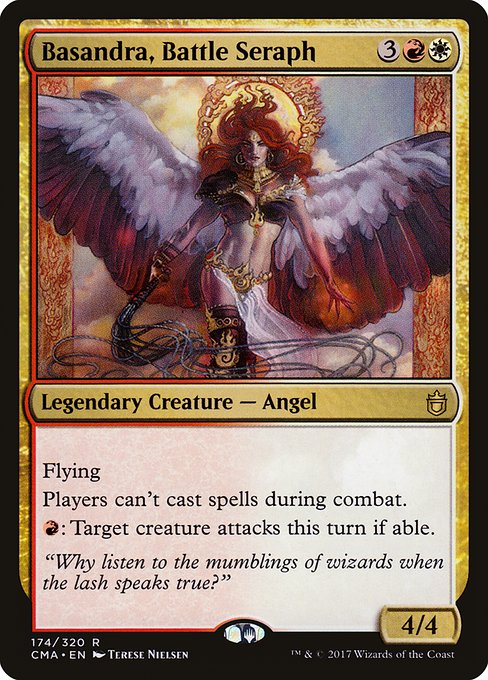
Image courtesy of Scryfall.com
The Illustrator's Legacy in Magic History
Every MTG fan has a favorite epoch where art and mechanics collided in a burst of color and imagination. For many, that moment centers on Terese Nielsen’s work—the bold lines, dramatic lighting, and emotional charge that turn a simple mana curve into a story you can feel in your bones. Basandra, Battle Seraph is a quintessential example of that era: a legendary Angel whose presence in Commander Anthology (CMA) serves as both a gameplay tool and a window into Nielsen’s enduring influence on the Multiverse 🧙♂️🔥💎. Released on 2017-06-09, this card shows how Nina-like grandeur and Warrior-Priest aesthetics can fuse into a policy-shaping combat figure, literally turning the battlefield into a stage for drama and strategy ⚔️🎨.
Basandra’s typography on the battlefield reads like a manifesto. With a mana cost of {3}{R}{W}, she demands red-white devotion and rewards players who lean into audacious, aggressive playstyles. A 4/4 flyer with the classic Angel silhouette, she carries the aura of a commander who doesn’t merely participate in battles—she orchestrates them. The text—“Flying. Players can't cast spells during combat. {R}: Target creature attacks this turn if able.”—puts a spotlight on the fragility and ferocity of the combat step. It’s a design decision that aligns with Nielsen’s penchant for high-stakes visuals: when Basandra enters, the air crackles with consequence, and every decision feels freighted with risk and opportunity 🧙♂️🔥.
“Why listen to the mumblings of wizards when the lash speaks true?”
The flavor text anchors Basandra in a world where authority is not gentle and counsel is often tempered by force. Nielsen’s illustration communicates that ethos at a glance: a celestial, radiant figure who imposes order with an unyielding gaze. The card’s color identity—Red and White—embodies the blistering pace of red and the steadfast, protective idealism of white. Together, they craft a resolve you can see as clearly as you can hear the clashing of metal, a signature vibe of Nielsen’s era that many collectors and players still chase today 🧭🎲.
Art, Mechanics, and the Legacy of a Signature Artist
In the span of MTG history, Nielsen’s pieces became touchstones for a generation of fans who learned to read a card’s illustration as a second text—one that speaks to the kind of world you’re about to enter. Basandra epitomizes her ability to render space and motion with cinematic clarity. The flying frame, the dramatic palette, and the sense of monumental scale all push the card beyond mere numbers into a narrative moment. As a reprint in CMA, Basandra also highlights how the Commander Anthology project curated a gallery of memorable voices from the past, reintroducing beloved art to players who came to the table with different memories of the game. The result isn’t just a collectible; it’s a memory map—tracing Nielsen’s contributions across sets and eras 🧙♂️🎨.
From a collecting perspective, Basandra exists at a crossroads. The “rare” rarity tag from CMA, combined with Nielsen’s trailblazing art, has kept the card in the consideration set for many nostalgia-driven decks and display cases. Contemporary price data hints at a value ladder that bounces around a few dollars in USD (roughly in the early 2-dollar range) with euro valuations hovering modestly lower. For fans who remember the late-90s and early-2000s MTG artwork boom, Basandra is both a portal to that aesthetic and a reminder of how an artist’s signature style continues to resonate in new formats, even as game design evolves 🌟💎.
Design Dialogues: How Basandra Shapes Play in Commander Circles
Basandra is a card that asks you to think in terms of tempo and threat management. The combination of flying and combat-spell suppression creates a unique dynamic: your opponent’s best plan to close the game through combat is suddenly thwarted, while you, with the right setup, can force awkward combat moments that tilt the battlefield in your favor. The activated ability—forcing a target creature to attack if able—amplifies the “battlefield storytelling” vibe: every creature you swing with is part of a larger narrative you’re steering. This makes Basandra a natural fit for commander environments where you’re curating a chorus of big plays, pump spells, and pressure that keeps opponents guessing. For players who love synergy between strategy and spectacle, Basandra delivers the kind of memorable, hands-on engagement that makes MTG matches feel like episodes of a favorite show 🧙♂️⚔️.
- Deckbuilding tip: Pair Basandra with aggressive red-white commanders to maximize your combat-phase control while you tempo out opponents who rely on instant-speed disruption.
- Gameplay angle: Use Basandra to force commitments during combat, then capitalize with targeted removal or high-impact finishers while your foes scramble to react.
- Artistic appreciation: The illustration’s luminous contrasts and upward motion beautifully mirror the card’s push-pull between protection and aggression—an artful reminder that MTG’s visuals amplify its rules text 🧙♂️🎲.
- Collector angle: As a CMA reprint with Nielsen’s signature style, Basandra appeals to fans who collect iconic art and sealed nostalgia—two birds with one sparkly stone 💎.
In a broader sense, Basandra, Battle Seraph embodies the cross-generational allure of Terese Nielsen’s art in MTG. Her pieces became shorthand for a certain bold optimism and mythic scale that still informs how new artists approach iconic creatures. The card’s aura—Flight, heft, and a combat-control edge—resonates in the community’s collective memory, helping fans connect with older sets while still feeling the pulse of modern, fast-paced play 🧙♂️.
If you’re a player who loves the narrative weight of a well-timed combat decision or a collector who savors the tactile thrill of a Nielsen illustration, Basandra offers both inspiration and utility. It’s not just about the numbers on the sheet; it’s about the moment when you announce a move and the board erupts into a chorus of flying seraphs and clashing blades. That’s the kind of legacy a single card can leave in a sprawling multiverse, and Terese Nielsen’s art remains one of the bright, enduring beacons of that history 🎨🔥.